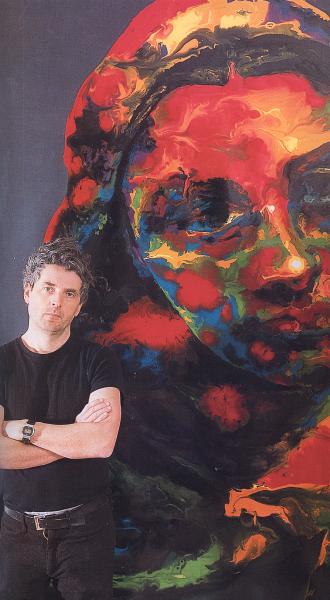Massimo Pulini exhibits in our gallery since 2008.
"The bright enamels on x-rays, set apart from the world of appearances, are creatures which belong to a timeless space of past emotions surviving as memories. The Artist prevails over the art historian in a hypothetical feeling that avoids the obligatory paths present and past. D.M. "From his visitation of the Koelliker paintings, paintings which come from different genres (religious, mythological), Pulini extracts, circumscribes, emphasises a face and thereby creates a "portrait". So the "meshing of parallel lives" which Pulini has always done in his art today also includes the great Italian collector, caught up in that vertiginous dimension of mirrors and amplifications which the artists structures, starting from his own cultural adherence, both affective and ethical. A poetic appears in these new works by Pulini which makes an archetype dimension prevail on individuality, like it was in the past. These "portraits" do not seize souls, feelings, psychologies or social statutes. Instead, they are placed on slippery, liquid plains where the routes of form cross over their own undoing. "The secret of form lies in the fact that it is the confine. It is the thing itself and, at the same time, the end of the thing. The circumscribed territory in which the Being and Not- Being-anymore of the thing are one", Geoge Simmel wrote. ...These surfaces which bring to mind sound waves and thermal waves" E.F.
Massimo Pulini was born in Cesena on 15 August 1958 and is Professor of Painting at the Academy of Fine Arts in Bologna.
Since 1976 he has exhibited his paintings in important private and public galleries, both Italian and international. He has exhibited several times in Paris at the Galleries Lavigne Bastille and Vandôme. At the beginning of the 80s he participated in fundamental exhibitions curated by the critics Maurizio Calvesi, Italo Tomassoni, Marisa Vescovo, Rossana Bossaglia, Paolo Portoghesi and Italo Mussa, which were at the origin of artistic groupings, variously defined: Anacronisti, Hypermannerists, Cultured Painting or New Italian Way.
In the mid-eighties, after having held a personal room at the XI Roman Quadriennale entitled Art as History of Art, he won the competition that led him to create a large work that will then be placed in Dallas (USA) in an architectural complex designed by Philip Johnson, recognized father of postmodern architecture.
These experiences led Massimo Pulini to face a long journey of individual research, always in dialogue with the History of Painting and with memory, which led him to hold large personal exhibitions in Italian, French and English Museums. In particular, we remember the exhibition that opened for the first time to contemporary art the National Museum of Villa Adriana in Tivoli (1997). The same year is the monograph staged at the Saline Royale in Besançon, while 1999 is his largest anthology, held at the National Gallery of Parma, with an exhibition involving the Farnese Theatre and all the halls of the Scuderie della Pilotta. In 2000 he was invited to set up his own 'quadreria' of works at the important retrospective exhibition on the "Novecento Italiano", held at the Scuderie Papali del Quirinale with the care of Maurizio Calvesi and Paul Ginsborg.
In 2002, commissioned by the Vatican Museums, he decorated the vault of one of the rooms of the papal apartments, painting two Angels bearing the coat of arms in the vestibule of the personal library of Pope John Paul II. He also performs the velario of the historic theater of Cesena Alessandro Bonci with a gigantic work on canvas.
In 2005 the Romberg Arte Contemporanea in Rome dedicated him the anthology entitled "Gallerie parallele". In 2006 the Italian Institute of Culture in London, on the recommendation of Sir Denis Mahon, the great scholar of the Italian Baroque, set up a vast personal exhibition with the publication of two volumes. Also in 2006 he was included in the cataloguing project: 10 artists for the cultural heritage of Emilia-Romagna, curated by Carmela Baldino and Claudia Collina. In 2007 he was invited to perform six works, selected by the commission led by Cardinal Betori and presided over by Pope Benedict XVI, which go to compose the illustrative kit of the official volumes of the Liturgical Lectionary, still in force. In 2009 he was invited by Cardinal Gianfranco Ravasi to the meeting between Pope Benedict XVI and artists, held in the Sistine Chapel.
For over thirty years, in parallel with his work as an artist, Massimo Pulini has been researching in the field of Art History, publishing various essays in scientific journals. Over the years he has published several books with the publishing house Medusa in Milan, contributed to theatrical plays and wrote novels.
From June 2011 until January 2019 he took on a commitment of civil responsibility at the Municipal Administration of Rimini and became a promoter of the Biennale Disegno, editing three editions of what has already distinguished itself as the largest international exhibition dedicated to the art of drawing, ancient and contemporary.
Critical texts on Massimo Pulini: Mariano Apa; Adriano Baccilieri; Paolo Balmas; Rossana Bossaglia; Maurizio Calvesi; Luciano Caprile; Maurizio Cecchetti; Claudia Collina; Rosita Copioli; Roberto Daolio; Andrea Emiliani; Lucia Fornari Schianchi; Franco Solmi; Sabrina Foschini; Eleonora Frattarolo; Giuseppe Gatt; Sergio Guarino; Domenico Guzzi; Sir Denis Mahon; Gianluca Marziani; Gabriello Milantoni; Italo Mussa; Giancarlo Papi; Paolo Portoghesi; Concetto Pozzati; Carlo Ragghianti; Eugenio Riccomini; Lorella Scacco; Claudio Spadoni; Carlo Federico Teodoro; Italo Tomassoni; Marisa Vescovo; Marco Vallora; Claudia Zanfi.




